Medical Detachment, 70th Tank Battalion Unit History
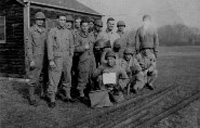
Group of personnel of the 70th Tank Battalion in front of one their barracks, at Fort George G. Meade, Baltimore, Maryland, in spring of 1941.
Introduction & Activation:
The Medical Detachment of the 70th Tank Battalion was activated on 1 January 1941 at Fort George G. Meade, Baltimore, Maryland (Army Ground Forces Training Center: acreage; 13,683, troop capacity; 85 Officers & 2,006 Enlisted Men –ed), but did not receive its proper personnel until 14 February 1941, at which time 2 Medical Officers and 18 Enlisted Men were assigned to the organization. At this time the unit only had one ½-ton 4 x 4 ambulance, two ½-ton 4 x 4 command and reconnaissance trucks, and one 2½-ton 6 x 6 truck plus the usual Battalion Aid Station equipment. Battalion patients; sick or wounded, were transferred to the Post Station Hospital for treatment.
The Medical Detachment’s parent organization was the 70th Tank Battalion (the oldest and most experienced independent Tank Battalion in the ETO), initially formed from 1st Battalion, 67th Infantry Regiment (Medium Tanks) then stationed at Fort George G. Meade, on 15 June 1940, under Lt. Colonel Stephen G. Henry, and redesignated 67th Armored Regiment 15 July 1940). Constituted 10 July 1940 in the Regular Army as the 70th Tank Battalion (Medium), and officially activated 15 July 1940, at Fort George G. Meade. Redesignated 70th Light Tank Battalion 7 October 1941 (inactivated 1 June 1946 in Bamberg, Germany, later reactivated once more for service in Korea –ed). Colonel T. N. Stark became the next Commanding Officer. The Battalion was built around Officers and Enlisted Men of the Regular Army, and after having been activated, furnished a cadre for training to the 1st Tank Group, Fort Knox.
Training:
Training consisted mainly of lectures on such subjects as: first-aid, bandaging, splinting, physiology, anatomy, given by the available Medical Officers. Several Enlisted personnel were sent to the Post Station Hospital and other medical institutions for surgical training, including 1 EM who was sent to Dental School to attend lectures on dental practice.
The Battalion, less A Company (sent to Fort Devens, Ayer, Massachusetts, for a contemplated movement overseas, which never materialized –ed) was sent to Tennessee for maneuvers. A Battalion Aid Station was set up during the Tennessee Maneuvers (1 June 1941 to 30 June 1941), and also during the Carolina Maneuvers (1 November 1941 to 30 November 1941). For the latter field exercise, the whole unit traveled south for participation. Apart from the lectures and tactical exercises, the usual “field problems” were practiced. These included treating, transporting, and evacuating of simulated casualties. Fortunately, no unusual problems were encountered other than the evacuation of men from tanks (armored vehicles) which remained a difficult problem, especially when the soldier was seriously wounded. C Company, equipped with M-3 light Stuart tanks was sent to Iceland in February 1942 to form the 10th Light Tank Company.
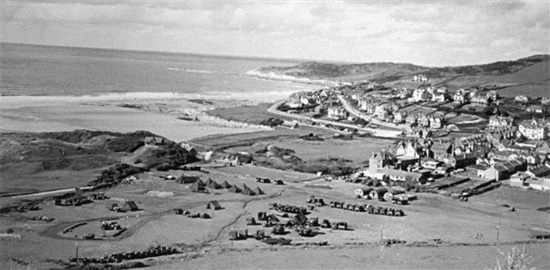
Aerial view illustrating the United States Assault Training Center at Woolacombe Beach, Devon, United Kingdom. The area became the most important training area for joint Army and Navy exercises and amphibious training in view of Operation “Neptune”.
(… wounded members of a tank crew will normally be removed from disabled vehicles by their fellow members. The operation requires the utmost speed to save the lives of those who are unhurt as of the casualty. A tank set afire by an enemy hit can trap its crew in a matter of seconds; and an enemy who has determined the range and disabled a tank with a direct hit will most probably continue shooting until the vehicle burns. It is therefore essential that all crew members become extremely proficient in the quickest methods of removing one another from the tank. Speed is the primary requisite. If the action has ceased momentarily, or the tank has been able to disengage itself without hindering the accomplishment of the mission, the casualty is removed on the spot and then carried to a protected place where emergency first-aid is administered.
The methods of evacuation are based on a two-man team, which is the largest number that can effectively work around a single hatch opening. In some cases a third man will be able to give considerable help from inside by placing belts around the wounded crew member or by moving him to a position where he can be grasped from above. Speed will usually dictate that the wounded casualty be grasped by portions of his clothing or by the arms for removal. If an arm is broken, however, or if there are other injuries which will be aggravated by such procedures and if time allows, some form of sling may be improvised which will relieve the part from further injury. Only equipment which is immediately available, such as pistol belts, web belts, or field bag straps, will be used for this purpose. Suggested use of some of the items, as well as more elaborate techniques of evacuation, will be found in the Armored Force Field Manual FM 17-80 “Medical Units in the Armored Division”-ed)
On 10 March 1942, the unit moved to Fort Bragg, Fayetteville, North Carolina (Field Artillery Replacement Training Center: acreage; 129,422, troop capacity; 4,311 Officers & 76,175 Enlisted Men –ed), and during its stay at the new station, the Medical Detachment received 3 half-track ambulances (M-3 vehicle type –ed). Some of the existing vehicles were exchanged for others. The ½-ton ambulance was replaced by the more modern version being the ¾-ton 4 x 4 ambulance. Meanwhile the training program continued and in the summer of 1942, the personnel were augmented by 1 Dental Officer and 2 more Medical Officers, giving the Detachment a total of 3 Medical Officers and 1 Dental Officer. At this time, training in first-aid was emphasized with stress being placed on the use of sulfa drugs, morphine, blood transfusion and plasma.
Major John C. Welborn, MC, O-18863, assumed command of the 70th Tank Battalion on 23 March 1942.
More practical exercises were conducted including, during May 1942, an amphibious operation which took place at Solomon’s Island, Cheasapeake Bay, Maryland, where one of the Battalion’s half-track ambulances made a landing on a lighter (landing barge –ed) behind the tanks. The crew on board the armored vehicle consisted of one Medical Officer and three Enlisted Men. Everyone was anticipating that action overseas would come soon.
T/O & E 17-25, dated 15 September 1943 – Tank Battalion
2 Officers (Captains or 1st Lieutenants)
20 Enlisted Men
1 ¼-ton Truck (aka Jeep)
1 ¾-ton Ambulance
2 ¾-ton Weapons Carriers
2 Half-Track Ambulances
3 ¼-ton Trailers
1 1-ton Trailer
In September 1942, orders for overseas movement came through and the Battalion was processed for embarkation and movement overseas 14 January 1943. The destination: North Africa.
Operation “Torch” – North Africa:
Initial honors would go first to A Company. Special credit would go to this Company for having assaulted the shores of Algeria near Cap Matifou, as part of the 39th Infantry Combat Team, 9th Infantry Division, on 8 November 1942. The 39th RCT was part of the Eastern Task Force under command of Major General Charles W. Ryder (the main body of the 70th Tank Battalion departed New York POE 14 January 1943, arriving in North Africa 26 January 1943 –ed). Attached medical personnel accompanied the units to the beach. Aid Stations were set up further inland and casualties evacuated to the beach and thence by LCT or LCVP to one of the British Hospital Ships equipped with the necessary surgical and hospital facilities. Aside from the organic Medical Clearing Platoons of the 9th Medical Battalion (9th Infantry Division) and the 109th Medical Battalion (34th Infantry Division), all hospitalization for the Eastern Task Force was British! All British medical units took American patients, with the bulk going to the British 94th General Hospital.
During the expansion into Tunisia, one crew eventually moved into this neighboring country and was in the thick of the pushing and the retreating for five and a half months. Evacuation in this critical period was very difficult at times, with casualties having to be transported over rough roads and dangerous terrain for twenty-five miles or more.
Attached to 9th Infantry Division (8 November 1942 > 11 November 1942)
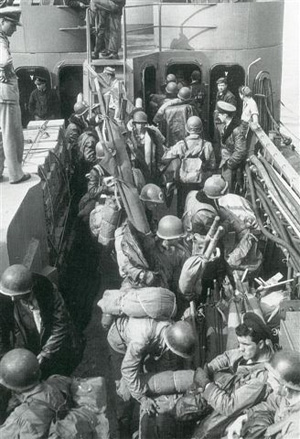
Rehearsal and practice invasion operations for D-Day, England. Troops, including Army Medical Detachment personnel and Navy 2d NBB Corpsmen on board of one of the participating Navy or Coast Guard vessels.
Field improvisations had to be made, including an improvised chest, as a No. 2 Chest was much too cumbersome to carry around. Many French soldiers and native Arabs were treated by the Battalion’s Medical Detachment around Pichon, Fondouk and the nearby Ousseltia valley in Tunisia. During this interlude, the major portion of the Battalion sojourned at Tlemcen, Algeria, where from all accounts a good time was had by all. Officers and NCOs were actively training newly-formed Free French armored units in the use of American tanks and other weapons provided under Lend-Lease.
Awards for the Tunisia Campaign were as follows: Silver Star to Captain Isadore Shechner, MC, and Private First Class Herbert B. Strasser; Legion of Merit to Technician 4th Grade Joseph Wasylyszyn.
Operation “Husky” – Sicily:
The 70th Tank Battalion staff and 36 EM landed at Gela, Sicily, on D+3 (13 July 1943) without vehicles and was the first element ashore, with the exception of a reconnaissance party of 2 Officers and Enlisted Men, who landed with the Army Rangers on 10 July 1943.
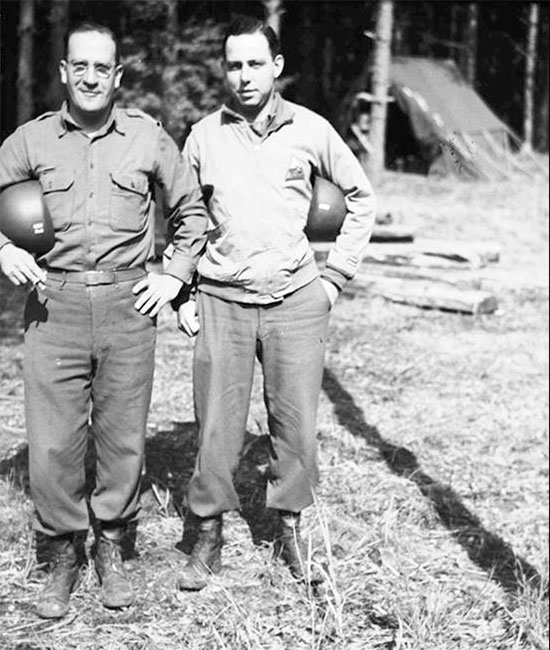
Photo illustrating Captain Isadore “Doc” Shechner, MC (left) together with an unidentified Officer of the 70th Tank Battalion (copyright Roberts Armory, via Michael A. Krizsanitz).
During the Sicilian Campaign, the 70th Tank Battalion for the first time fought together as a unit and the Medical Detachment was able to operate more efficiently being directed by radio to casualties, who were then picked up, treated at an improvised Aid Station, and then taken to the rear to an Evacuation Hospital. This kind of “setup” allowed for more than first-aid to be administered. For example, blood plasma could be given or necessary splints applied so that the patient was able to withstand a long haul with more comfort and reach a hospital in fairly good condition. In this campaign, and following the learning experience in Algeria and Tunisia, the men perfectly understood their duties and performed with efficiency and in many instances, with outstanding courage and intrepidity under heavy enemy fire. Burns were a frequent cause of casualties and the simple treatment with boric acid ointment was found to be as effective as a first-aid measure as any method previously used.
The Medical Detachment suffered one casualty, Captain Donald K. Flessa, MC, who was killed 22 July 1943 while gallantly bringing succor to the wounded. Many Infantry soldiers were treated by the Detachment in Sicily, as they sometimes were the closest medical personnel. Captain D. K. Flessa replaced Captain Charles R. Sharp, who was transferred to Ft. Campbell, Hopkinsville, Kentucky (Armored Division Camp).
Following the campaign, it was found necessary to familiarize the men more intently with the use of plasma and how to assemble and prepare the unit in order to expedite its administration. Some of the men, the Surgical Technicians in particular, were taught to conduct intravenous injections. Further instruction was given again later when in England while training for the invasion of the Continent. Only by the actual handling of the plasma could a man learn to quickly set it up ready to administer it to a needy patient. Up to this time in war, emphasis had not been laid on the correct filling out of Medical Form 52b (EMT- Emergency Medical Tag –ed), and this resulted in many errors and omissions. However, by numerous classes, this was corrected in due time. No daily casualty reports were made by the Detachment. This was solved by the use of ETO Medical Department Form 324a which undoubtedly improved the statistical reporting of casualties sustained by the Battalion.
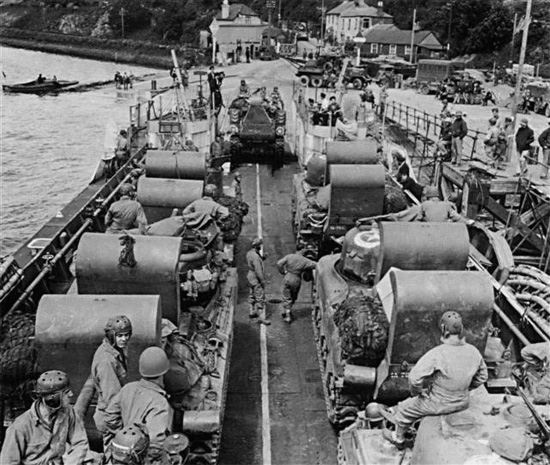
M-4 Sherman tanks of the 70th Tank Battalion are loaded onto an LCT at Kingswear, England. This could be part of D-Day training and landing exercises, or the ‘real’ thing, preparations for Operation “Neptune”. Note the air intakes and exhausts installed for landing operations.
Attached to 1st Infantry Division (13 July 1943 > 17 August 1943)
Attached to 45th Infantry Division (C Co 24 July 1943 > 25 July 1943)
Due to the rather high incidence of VD in the countries where the Battalion served, the men were encouraged to indulge in sports, and to play softball, football, and practice athletics. Lectures and occasional venereal disease motion pictures were shown. Condoms and pro-packets were offered to the Enlisted personnel and a Prophylactic Station was always made available. No instance of VD occurred in the Medical Detachment, and the rate of venereal disease in the 70th Tank Battalion was constantly low.
The abundance of fruits and vegetables in these semi-tropical countries and the occasional purchase of a steer proved a great morale factor in feeding, as up to the time the standard ration (C and K-rations) had not been improved upon and were very monotonous and rather unpalatable. Plagues of tropical insects wrought a great deal of havoc, and many succumbed and had to be hospitalized with malaria and dysentery, neither of which could be effectively controlled in the field. A fair number of men were able to suppress malaria with the “religious” use of Atabrine, but only to have it flare up again when they were in England, and later in France. Ordinary diarrhea was common and was managed with the usual drugs and the additional use of sulfaguanidine. Admittedly the promiscuous imbibing of Marsala and Vin Blanc may have had nothing to do with the numerous cases of diarrhea and gastric disorders. However, no great harm resulted and apparently did not prevent everyone from having a pleasant boat trip to the United Kingdom where the Battalion disembarked Thanksgiving Day 1943.
Personnel Losses – 70th Tank Battalion (Sicily)
10 Killed in Action
28 Wounded in Action
1 Missing in Action
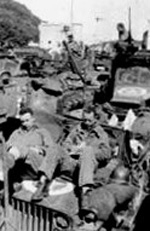
4 June 1944, Portsmouth, England. Personnel of the 70th Tank Battalion, crammed on board a Navy LCT, waiting for orders to “go”…
United Kingdom:
While in England, all elements of the Battalion received the necessary preparation for the Invasion of France and at all times were accompanied by at least one Medical Officer and some aid men, who participated in the training only as it applied to them and rendered aid to the sick and injured. Emphasis was again laid upon the treatment of gunshot or shrapnel wounds and resuscitation as casualties from drowning and carbon monoxide poisoning had always to be anticipated. The latter was especially important as work in cooperation with amphibious (DD > Duplex Drive tanks –ed) tanks revealed that on occasions some members of tank crews could be overcome by carbon monoxide poisoning. Although some of the landing DD tanks were expected to go down, there were no cases of drowning due to the use of breathing apparatus, automatic inflating rubber boats and the speedy recovery of the men, when lost at sea during debarkation operations (this was particularly the case during Operation “Neptune”).
Following Movement Order # 1, issued by Headquarters, 4th Infantry Division, APO 4, dated 25 February 1944, the 4th Infantry Division, with some organic and attached troops, was instructed to participate in landing exercises at the US Assault Training Center, Woolacombe, England during the period 1 to 15 March 1944.
The 70th Tank Battalion was stationed at Barton Stacey, Hampshire, England. The unit was officially attached to the 4th Infantry Division, per Official Letter, Headquarters VII Corps, dated 6 March 1944. A and B Companies left for Great Yarmouth, Norfolk, England, where they trained from 4 to 21 March 1944. C and D Companies moved to the Castlemartin Firing Range, Pembroke, Wales, for extensive training.
Based upon instructions contained in Movement Order # 10, dated 22 April 1944, the 70th Tank Battalion was ordered to attend amphibious training operations at the Center on 23 April 1944. A total of 2 Officers accompanied by 24 Enlisted Men were henceforth detached to Woolacombe, Devon, England (British Commando facility in Devon –ed) and stationed at Lupton Camp No. 6. The ATC School was in fact designed to instruct personnel up to regimental sized operations, which lasted about 3 to 4 weeks, after which the units would transfer to another training area for larger scale amphibious exercises, such as Slapton Sands. A Company departed for specialized secret training at Torcross, Devon, 1 April 1944; B Company followed on 8 April 1944; C Company left on 14 April 1944; and D Company departed from Sion Abbey, Devon, on 23 April 1944, to act as “enemy” troops in Exercise “Tiger”. The rest of the Battalion operated as “friendly” forces during Exercise “Tiger”, from 27 until 30 April 1944.

6 June 1944. American troops and 1/4-ton jeeps on board a Coast Guard-operated LCT on their way to Utah Beach. The Invasion of the continent is on!
Initially, the Medical Detachment treated many cases of upper respiratory infections and diarrhea while in England. This was mainly attributed to the radical change of environment and climate, quite a difference from the semi-tropical countries the organization had previously gone through.
Apart from the extensive training programs, recreation facilities were numerous and liberal passes granted to nearby towns and to the city of London. Food and messing were of a high standard and the stay in England was fine for morale in general. The common, though different, language was certainly an advantage, although men had to learn and adapt to British customs and currency. One difficulty in the supply line was obtaining adequate quantities of cough mixtures. Great success was obtained with the use of 50% icthyhol ointment in the treatment of furuncles, especially when it was inconvenient for the soldier to use hot soaks. During this period, as was the custom in all rest periods, the organization’s Dental Officer set up and offered all the necessary treatments. He also took impressions and completed the fitting of dentures for approximately thirty men. In cases where adequate dental treatment could not be administered, the patient was taken to a Station Hospital where facilities were more numerous for proper treatment. Considering the local circumstances, the venereal rate was kept to a strict minimum by the use of prophylactic measures and the reiteration of “Sex Talks” lectures.
Personnel Strength – 70th Tank Battalion
31 March 1944 > 43 Officers + 3 Warrant Officers + 765 Enlisted Men
30 April 1944 > 43 Officers + 4 Warrant Officers + 757 Enlisted Men
Attached to 4th Infantry Division (6 March 1944 > 6 June 1944)
France:
Since combat experience had shown that it was worthwhile to attach independent Tank Battalions to Infantry and Airborne Divisions, it became standard procedure to assign large units with armor. The 4th Infantry Division was assigned the 70th Tank Battalion for the D-Day assault. Two of the Tank Companies were therefore equipped with amphibious DD medium Sherman tanks, provided with a canvas and rubber skirt to make the vehicle buoyant enough to float (testing of these special vehicles started in March 1944 and was handled with great secrecy –ed).
The Battalion assault groups taking part in the D-Day operations on the Continent departed from ports in Devonshire, England as follows:
- 3 June 1944 – Headquarters Company, A + C + D Companies, departed from Darthmouth.
- 3 June 1944 – B Company, departed from Torcross.
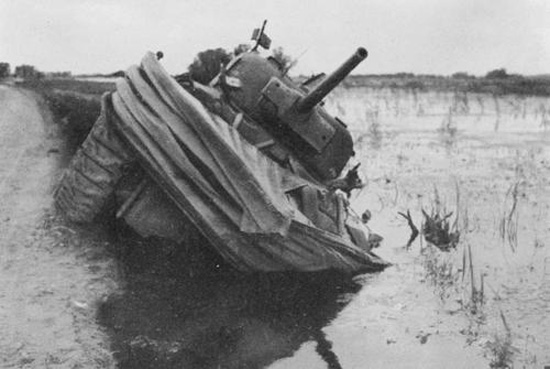
7 June 1944. Abandoned DD (Duplex Drive) Sherman tank of the 70th Tank Battalion at Utah Beach, Normandy. The vehicle probably belonged to either A or B Company.
(The residual groups, consisting of elements pertaining to Headquarters Company, Service Company, Medical Detachment, and rear echelon personnel, departed from Southampton on 14 and 20 June 1944, arriving at Omaha Beach, Normandy, France, on 16 and 23 June respectively –ed).
For the assault on Utah Beach at H-Hour (0630), A Company, would support the landings of the First Battalion, 8th Infantry Regiment on Tare (Green); B Company was to assist the Second Battalion of the 8th Infantry Regiment on Uncle (Red); and C Company was to aid the Beach Obstacle Task Force Engineers with clearing beach obstacles with help from their tankdozers at H+15, while the standard M-4 Sherman tanks would try and push further inland from the beaches. The light M-5 Stuart tanks belonging to D Company would land later and were to proceed to an assembly area near Ste-Marie-du-Mont, in order to be attached to the 101st Airborne Division. Official losses consisted of 9 medium tanks lost at sea, and 7 on land.
70th Tank Battalion CO – Lieutenant Colonel John C. Welborn, O-18863
+ Major Henry E. Davidson, Jr.
A Company CO – Captain J. Stewart Williams, O-456046
+ First Lieutenant DeWitt C. Fair, O-1012336
B Company CO – First Lieutenant Francis E. Songer, O-101180
+ Second Lieutenant John N. Townsend, O-1015121
+ First Lieutenant Herman Finkelstein, O-389264
C Company CO – First Lieutenant John L. Ahearn, O-1011621
+ First Lieutenant Dwight McKay, O-1012042
+ Captain Albert M. Krekler, O-456146
+ First Lieutenant Benjamin J. Riley, O-1011260
D Company CO – First Lieutenant Gordon R. Brodie, O-1012305
Headquarters Company CO – Captain Kenneth J. Krach, O-340750
Service Company CO – Captain Lewis C. Taynton, O-378695
Battalion Surgeon – Captain Isadore Shechner
One day after the invasion, 7 June 1944, one Medical Officer and crew of a half-track ambulance landed and aided with the evacuation and treatment of casualties from the First and Second Battalions, 8th Infantry Regiment, and the Third Battalion, 22d Infantry Regiment. After overcoming beach and some coastal defenses, the Companies advance inland towards Ste-Marie-du-Mont. Forward echelon elements spent the night in the vicinity of Audouville-la-Hubert. Contacts were subsequently made with elements of the 82d Airborne Division later in the day. Ste-Mère-Eglise was the center of operations and besides Battalion personnel, the place was bristling with infantry and paratroopers requiring medical care and treatment. The remainder of the unit’s Medical Detachment only joined the Battalion near Montebourg on D+4 and set up an Aid Station near the Battalion CP. It was here that the men used the plasma to good advantage, thus enabling to evacuate its patients in fair condition back to the beaches. Many of these were brought in jeep-ambulances belonging to the respective units of the wounded. The half-track ambulances, although helpful, were found too clumsy and sometimes unable to follow the tanks, which were spread out as they were assigned to each individual Regiment of the 4th Infantry Division. The 70th Tk Bn was detached from the 4th infantry Division on D+10, and went in Corps Reserve, being moved to an area west of Ste-Mère-Eglise, where it was rejoined by D Company, recently released by the 101st Airborne Division.
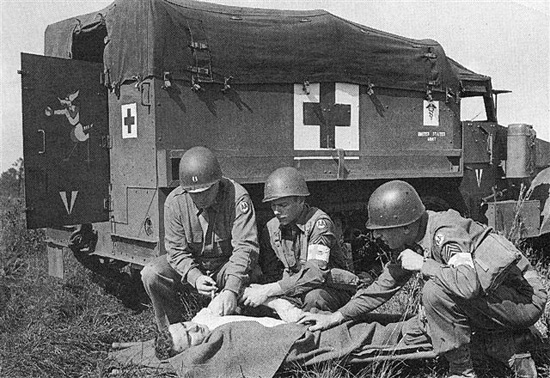
Illustration of a Half-Track ambulance. The armored vehicle illustrated is identical to the type of ambulance in use with the 70th Tank Battalion during operations in the European Theater.
After the Cherbourg campaign (Cherbourg fell on 27 June 1944 –ed), the Medical Detachment became more static until the St. Lô breakthrough and the rapid movement often made it impossible to handle the unit’s own casualties. This condition continued and remained difficult until the situation became once more comparatively static at the Siegfried Line, where most casualties were either treated at the Infantry Battalion Aid Stations, or if only lightly wounded, evacuated and brought to the Medical Detachment for treatment.
Personnel Losses – 70th Tank Battalion (France)
45 Killed in Action
129 Wounded in Action
45 Missing in Action
During the march through France, the Battalion suffered several bombing raids and one in particular caused numerous casualties. The greatest difficulty was treating patients in the dark. In September 1944, a Medical Officer and a Medical Administrative Corps Officer were transferred out of the Battalion and a MAC Officer was newly assigned as the Battalion Surgeon’s assistant as required by the new Table of Organization and Equipment (T/O & E 17-25, Change C5, dated 16 June 1944).
Personnel Strength – 70th Tank Battalion
6 June 1944 > 43 Officers + 4 Warrant Officers + 735 Enlisted Men
30 June 1944 > 45 Officers + 4 Warrant Officers + 770 Enlisted Men
31 July 1944 > 43 Officers + 3 Warrant Officers + 691 Enlisted Men
Attached to 4th Infantry Division (6 June 1944 > 16 June 1944) + (18 June 1944 > 29 June 1944)
Attached to101st Airborne Division (D Co 7 June 1944 > 16 June 1944)
Attached to 82d Airborne Division (29 June 1944)
Attached to 83d Infantry Division (17 July 1944 > 18 July 1944)
Attached to 4th Infantry Division (30 June 1944 > 5 September 1944)
Major Henry E. Davidson, Jr. became the new Battalion Commander.
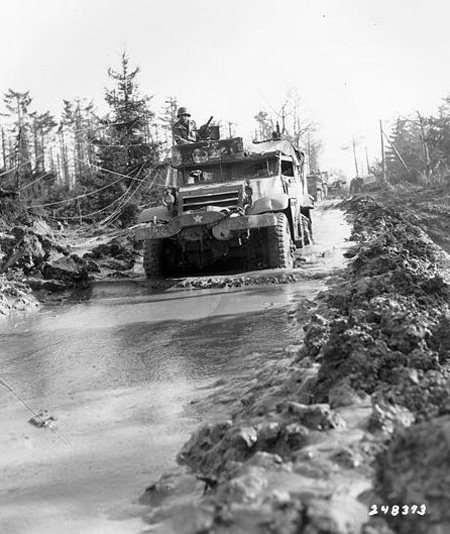
November 1944. View illustrating the kind of terrain encountered in the Hürtgen Forest, Germany. Almost impassible for heavy vehicles, including armor, and barely surmounted by light tracked vehicles and jeeps
Personal awards for the Normandy and Northern France Campaigns were as follows: Distinguished Service Cross for Lieutenant Colonel John C. Welborn, First Lieutenant John L. Ahearn, First Lieutenant DeWitt C. Fair, First Lieutenant Francis E. Songer, Second Lieutenant John N. Townsend, Staff Sergeant Darvin D. Purvis, Staff Sergeant Richard C. Murrin, and Sergeant Henry V. Nothel; Legion of Merit for Lieutenant Colonel John C. Welborn; Silver Star for First Lieutenant Herman Finkelstein, First Lieutenant Dwight McKay, Second Lieutenant Thomas J. Tighe (posthumous), Staff Sergeant Benjamin W. Griffin, Sergeant George E. Bailey, Sergeant Richard V. Ekstrom (posthumous), Sergeant Edward H. C. Lakin, Sergeant Robert L. O’Dell, Corporal William K. Brown (posthumous), Corporal John J. Haas, and Private Emerson C. Kirk; Bronze Star for Sergeant John H. Dixon, Sergeant Paul Jones, Corporal Michael Shuhala, Technician 4th Grade Clarence D. Ashberger (posthumous), Private Thomas J. Hale and Private Frank A. Madonna.
Belgium:
The 4th Infantry Division turned eastwards in a final sweep across the Meuse River and the Franco-Belgian border, heading in the general direction of Germany and its Siegfried Line. The unit crossed into Belgium 6 September 1944 and following one of its reconnaissance patrols, entered Germany the evening of 11 September.
Germany:
After leaving Belgium, the Allied Armies continued their advance toward Germany. In order to try and pin down enemy forces to keep them from reinforcing their lines north of Aachen, First United States Army decided to advance through the Hürtgenwald, situated east of the Belgo-German border. As the Germans fiercely defended the area, it became a very costly battle with US losses estimated at approximately 33,000, and bitter fighting lasting from mid-September 1944 to early February 1945. The dense forest and rough terrain, only broken by firebreaks, dirt roads, and tracks, restricted regular vehicle and armor movement, and because of the season, the weather was cold, wet, and cloudy, often preventing air support. Notwithstanding the overall superiority of the attackers, the Americans took many casualties, requiring inexperienced units and recruits to act as replacements. Medical evacuation was hectic, and supply of ammunition and other critical items was almost impossible. The battered 9th Infantry Division was relieved by the 28th Infantry Division end October 1944. On 6 November 1944, the 12th Infantry Regiment was temporarily detached from the 4th Infantry Division and sent in to reinforce the 28th Infantry Division. The Kall valley being cut off by the Germans who controlled the heights rained down artillery and mortar fire onto the dug-in attackers causing many casualties. Thanks to a German Regimental Medical Officer an unofficial ceasefire was negotiated from 7 to 12 November 1944, in order to attend to the wounded of both sides. Evacuation of the casualties remained a problem with many wounded brought out by litter bearers or loaded on jeeps. The 4th Infantry Division fully committed in the Hürtgen Forest, almost lost its 12th Infantry Regiment (heavily mauled from previous action in the area –ed), and was left with barely 2 effective Regiments to achieve its other divisional objectives.
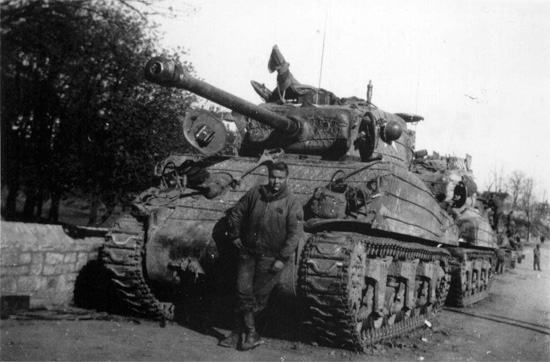
M-4 medium tanks of the 70th Tank Battalion at rest somewhere in Germany. Most probably waiting to be resupplied with gas, ammo, and rations … in order to resume its advance through Germany.
Although climatic conditions were poor, there were only a very small percentage of trench foot cases, which were immediately evacuated to the rear, depending on the available transportation. Some frostbite cases also developed. Combat exhaustion cases could only be returned to duty if allowed to rest, get plenty of sleep, and receive a bath. Most of these cases however were evacuated to the 4th Medical Battalion’s Medical Clearing Company.
Grand-Duchy of Luxembourg:
After wallowing in the mud at the Hürtgen Forest, the unit was greatly relieved by a move to Luxembourg. During the first week of December 1944, the Medical Detachment established an Aid Station and worked in conjunction with the 12th Infantry Regiment. Some casualties were received but not many. After a good week, the unit returned for some rest in the city of Luxembourg on 12 December 1944, where training was resumed. Facilities for recreation were not numerous, considering the tactical military situation, but the majority of the Detachment’s personnel found some enjoyable pass times. There were numerous refractory cases of diarrhea associated with gastric upset, but most of these eventually responded to treatment of belladonna and sulfaguanidine. The cause of this condition could not be attributed to anything specific, even the Schnapps was excused as some teetotalers also were victims. The area was considered as a quiet sector where battle-weary units could rest, receive vitally needed supplies and replacements. Motorized equipment, especially tanks stood partially disassembled for much needed repairs. Here the 70th Tank Battalion saw some action during the German breakthrough which erupted on 16 December 1944.
The entire Battalion enjoyed a very nice Christmas meal in the city of Luxembourg at the Bel Air School. This became the first occasion in many months that the organization could really sit down to a meal together and it was certainly appropriately a festive affair for all. By 26 December the enemy thrust toward Luxembourg’s capital city had been hurled back, and American troops were able to attack the ‘shoulders’ of the Bulge, crossing the Sauer River 18 January 1945. During the last days of the month, the 4th Infantry Division departed Luxembourg marching through Bastogne, Belgium, and prepared to attack the Germans in the Our River area, once more pushing forward toward the enemy’s Fatherland.
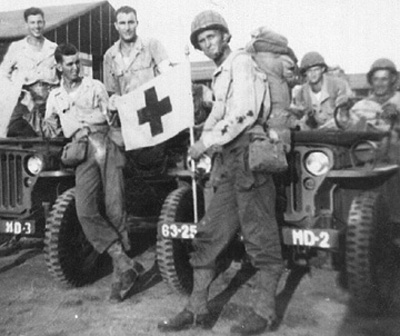
March 1945, Germany. When attached to Infantry or Airborne Divisions for armored support, the Medical Detachment personnel of the 70th Tank Battalion often worked together with other ‘medics’ pertaining to different organizations. This picture illustrates members of the Medical Detachment, 254th Infantry Regiment, 63d Infantry Division. The 70th Tank Battalion was temporarily attached to the 63d Infantry Division from 12 to 18 March 1945.
Germany:
During the Saar-Palatinate campaign, Third and Seventh United States Armies confronted one of the richest industrial regions of the Third Reich. Seventh US Army, bordered on its left by the Third United States Army and on its right by the First French Army was to lead the offensive and breach the Siegfried Line. The 63d Infantry Division had received as primary task to penetrate the Siegfried Line and started its assault on 15 March 1945. Advance was made against heavy enemy artillery and mortar fire and numerous antipersonnel mines. Since it had to withstand heavy enemy counterattacks by tank-supported infantry, the 70th Tank Battalion was attached to the Division. The breach was made with full penetration achieved by three Divisions; the 63d – the 45th – and the 3d Infantry.
The Siegfried Line along the Seventh US Army front included a continuous belt of dragon teeth built in three staggered rows of concrete pyramids, with behind them two antitank ditches, supported by reinforced pillboxes with interlocking fields of fire, barbed wire entanglements, and other obstacles. Engineer elements with explosives, pole and satchel charges were called in to assist with the reduction of minefields, bunkers and pillboxes. A provisional TF composed of medium tanks, tank destroyers, infantry, engineers, and a tank dozer moved in. The advance was costly and breaches were only obtained after repeated attempts (48 pillboxes were eliminated on 19 March 1945 –ed). The Battalion’s Medical Detachment provided some basic support together with other medical personnel pertaining to the 254th Infantry Regiment (63d Infantry Division –ed). The majority of the wounded were evacuated with assistance from the Collecting Companies of the 363d Medical Battalion and transported to the rear.
Attached to 63d Infantry Division (12 March 1945 > 18 March 1945)
Attached to 4th Infantry Division (23 March 1945 > 27 March 1945)
Attached to 4th Infantry Division (6 April 1945 > 9 May 1945)
Note: During the entire campaign in the European Theater of Operations, all medical supplies were obtained from the 4th Medical Battalion, 4th Infantry Division, the reason being that most of the time the 70th Tank Battalion was attached to this Division (except for some limited periods dictated by tactical conditions –ed). No difficulties were ever encountered in being provided with the necessary medical supplies and it should be noted that all requisitions were filled as quickly as possible. The 4th Medical Battalion and its Collecting and Clearing Companies cooperated 100% in all phases of evacuation and treatment of the Battalion’s sick and wounded.
Campaign Credits – 70th Tank Battalion
Algeria – French Morocco
Sicily
Normandy
Northern France
Rhineland
Ardennes-Alsace
Central Europe
Awards – 70th Tank Battalion
Army Distinguished Unit Badge – Cotentin Peninsula (France) 6 June 1944
Unit Citation – Normandy (France) 17 June 1944
Unit Citation – Northern France (France) 14 August 1944
Army Distinguished Unit Badge – Hürtgen Forest (Germany) 16 November – 4 December 1944
Belgian Fourragère (cited twice in the Order of the Day, Belgian Army) 20 November 1945
St. Vith (Belgium) 7 – 13 September 1944
Ardennes (Belgium) 16 – 21 December 1944

Lieutenant C. Welborn, MC, O-18863, Commanding Officer, 70th Tank Battalion, is being awarded the Distinguished Service Cross for his actions on D-Day, Normandy (ref. General Orders # 35, Headquarters, First United States Army, dated 19 July 1944).
Medical Detachment Roster:
| BRABHAM, Coleman G. | BREHM, Peter E. |
| BURKET, John H. | CHAVEZ, Seferino B. |
| CLICKNER, Harold J. | COOK, Andrew J. |
| COWAN, Stanley R. | CRUMLEY, Merle E. |
| DORSEY, William A. | EATON, James S. |
| EDWARDS, Daniel A. | FEDERINKO, George |
| FEENEY, James F. | FLESSA, Donald K. |
| FREDERICKSON, Chester L. | FRINSTEIN, George J. |
| GEORGE, Edward M. | GURIEL, Dominick P. |
| HOWER, Joseph W. | KEISER, Peter C. |
| KESSLER, George W. | KOVNER, Harry |
| KRUPICZ, Edward | LEE, George D. |
| LEVIN, David | LUNGER, LeRoy W. |
| MERRILL, Roy M. | MIODUSZEWSKI, Bernard |
| MUSIL, Emil G. | MUSSO, Dominic J. |
| NALESNYK, Michael | ORR, Robert A. |
| PALACINO, Joseph L. | PESANSKI, Charley |
| RUGG, William A. | SCHIFF, Benne |
| SHECHNER, Isadore | STRASSER, Herbert B. |
| SWANK, John W., Jr. | TODD, Archie |
| WALSWEER, Cornelius J. | WASYLYSZYN, Joseph |
| WEAVER, Walter H. | WILSON, James W. |
| WISNEFSKI, Joseph |

Operations Map of the 70th Tank Battalion during World War II.
The MRC Staff are truly indebted to Lynn F. McNulty, who once more provided them with copies of official Unit Reports enabling them to edit a concise Unit History of the Medical Detachment of the 70th Tank Battalion for their web pages. Our heartfelt thanks Lynn. Some of the photos are courtesy of Jonathan Gawne (author of “Spearheading D-Day”). The MRC is still looking for more data covering the final stay of the unit in the ETO and its subsequent return to the Zone of Interior. Sincere thanks to Michael Krizsanitz for generously sharing the Medical Detachment’s Personnel Roster and some photos with us.
